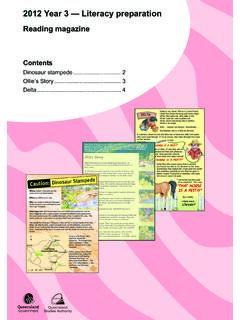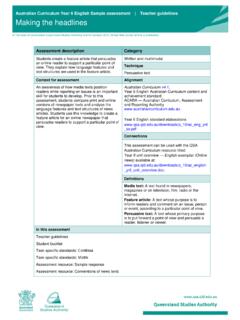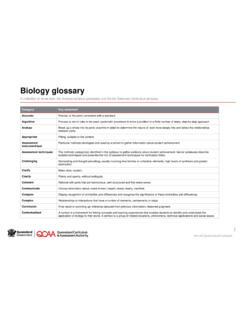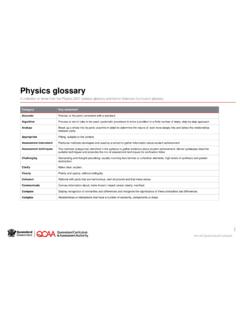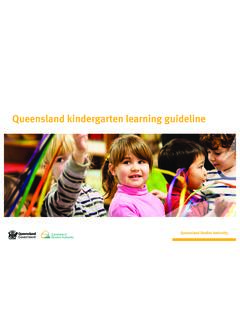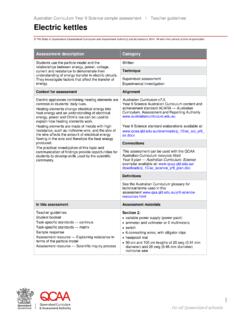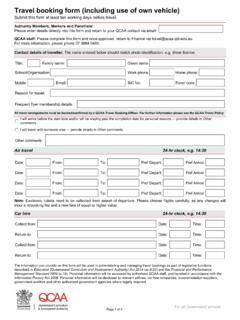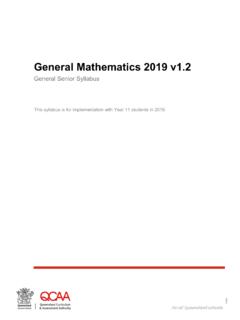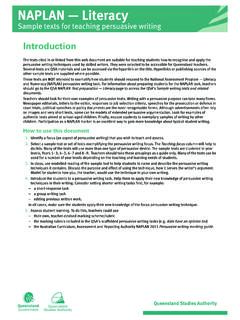Transcription of Teaching reading and viewing: Comprehension strategies …
1 150623 Teaching reading and viewing Comprehension strategies and activities for Years 1 9 September 2010 Introduction Teaching students to become effective readers is an important goal of the compulsory years of schooling. It involves extending student s vocabularies and knowledge of the world, developing their knowledge of English grammar and their decoding skills, developing their reading fluency and extending their ability to comprehend what they read and view from the literal level to the inferential and critical levels. This booklet provides teachers with a collection of strategies and activities for developing students Comprehension .
2 It is a companion document to the series of guides on Teaching reading and viewing . While the strategies are listed alphabetically in the table of contents, by using the matrix teachers can readily identify those that are suitable for their students Year level. The strategies and activities are also categorised according to the stages of the reading process that they support: activating, expanding and refining prior knowledge retrieving information interpreting texts reflecting and creating personal knowledge. These are the same stages described in the guides on Teaching reading and viewing . Contents Page Strategy Activating prior knowledge Retrieving information Interpreting Reflecting Year level 1 2 3 4 5 6 7 8 9 1 1.
3 Be a strategic reader 2 Turn on the meaning X X X X X X X X 6 Find the hidden meaning X X X X X X X 10 Be a reading detective X X X X X X X X X 14 Track down the main idea X X X X X X X 19 Build bridges to meaning X X X X X X X X 22 Weave ideas while reading X X X X X X X X X 25 Round up your ideas X X X X X X X X X X 27 2. Categorising and reviewing X X X X X X X X X X X 28 3. Contextual definition X X X X X X X X X X 29 4. Dialogical thinking while reading X X X X X X X 31 5. Expert panel X X X X X X X X X X 32 6. Inking your thinking X X X X X X X X X X X 35 7.
4 Inquiry chart X X X X X X X X 37 8. KWL X X X X X X X X X X X X X 39 9. Learning logs X X X X 41 10. Mental imagery X X X X X X X X X X X 42 11. Oral cloze / Zip cloze X X X X X X X X X X X 43 12. Possible sentences X X X X X X X X 44 13. Producing shared texts X X X X X 46 14. reading aloud X X X X X X X X X X 47 15. Reciprocal Teaching X X X X X X X X X X 52 16. Say something X X X X X X X X X X X 54 17. Semantic vocabulary map X X X X X X X X X X 55 18. Semantic webs/ concept maps X X X X X X X X X X X X 57 19. Shared reading X X X X X X X X X X 59 20. Skimming and scanning X X X X 61 21.
5 Starting with brainstorming X X X X X X X X X X 62 22. Story mapping X X X X X X X X X X X 63 23. Talking places/Graffiti walls X X X X X X X X X X 65 24. That reminds me X X X X X X X X X X X X 67 25. Top-level structuring X X X X X X X X X X X X X 68 26. USSR X X X X X X X X X X X 69 27. Visualising X X X X X X X X X X X Teaching reading and viewing Comprehension strategies and activities for Years 1 9 Queensland Curriculum & Assessment Authority September 2010 Page 1 of 69 1 Be a strategic reader .. The seven activities that make up this strategy have been adapted from the work of Scott G Paris. These activities are sequential, with each activity building on knowledge and understanding developed in the preceding activities.
6 Each activity has a poster for classroom use. Some also have ready-to-use activity sheets. Turn on the meaning: Recognising three kinds of meaning Find the hidden meaning: Understanding ambiguity and inference Be a reading detective: Evaluating the reading task Track down the main idea: Using clues to find the main idea Build bridges to meaning: Using context and prior knowledge Weave ideas while reading : Elaborating on text information Round up your ideas: Summarising main points Acknowledgment This strategy is based on ideas from: Paris, Scott G 1987, reading and Thinking strategies , DC Heath, Lexington MA.
7 Teaching reading and viewing Comprehension strategies and activities for Years 1 9 Queensland Curriculum & Assessment Authority September 2010 Page 2 of 69 Years 1 9 Turn on the meaning Recognising three kinds of meaning Using a light-bulb metaphor, students learn about the mental processes involved in activating ideas and making connections between known and new ideas. Learning focus The strategy makes students aware that three different kinds of meaning can be constructed during reading literal, inferential and personal. They develop understanding that a reader s prior knowledge plays a significant role in constructing meaning and that multiple meanings exist around a text.
8 Suggested implementation 1. Introduce the metaphor of turning on a light in a person s mind when they have a bright idea . Ask the question, How is getting an idea like turning on a light bulb in your mind? 2. Explain that as they read, students can turn on the meaning by using questions as switches to help them understand the writer s ideas. 3. Ask students if there is only one meaning in a text. Discuss how there can be more than one interpretation, more than one kind of meaning. 4. Introduce the poster for this activity. Explain that there are three different kinds of light bulbs on the poster and that we are going to learn how to turn on the meaning for each one of them.
9 5. Draw students attention to the first light bulb and explain that readers sometimes don t understand what they are reading because they don t understand the words. Explain that what the words say is one kind of meaning, and it is called the literal meaning. 6. Draw students attention to the second light bulb and explain that sometimes sentences mean more than just what the words say. As readers construct meaning they make inferences these are ideas suggested by the words. When readers link these inferences to other things they know, or other parts of the text, they are constructing inferential meaning. 7. Talk about the third light bulb.
10 Explain that an idea in a text can have special significance for some people because it connects to something personal to them; it might remind them of what happened to them or how they felt in the past. People can make personal meaning when they read any text. Information in texts can mean different things to different people. 8. Ask students to read Blinky Bill on the activity sheet. Work through the guided reading questions and discuss the different levels of Comprehension involved in answering the questions. As you work through the inferential questions, show students that the story did not say these things exactly.
